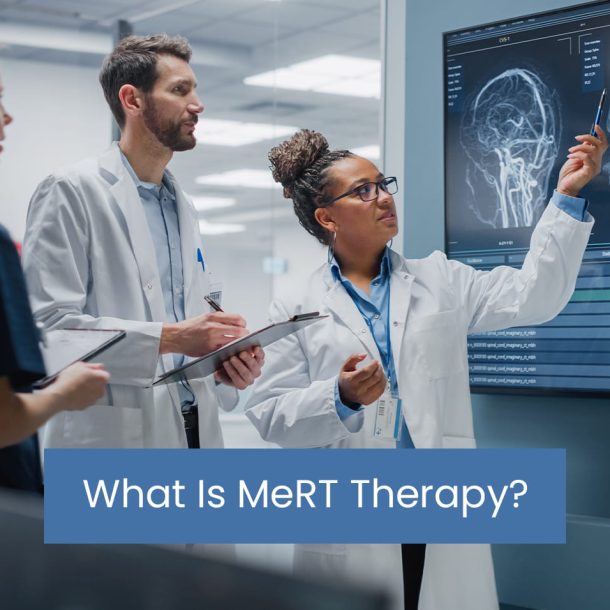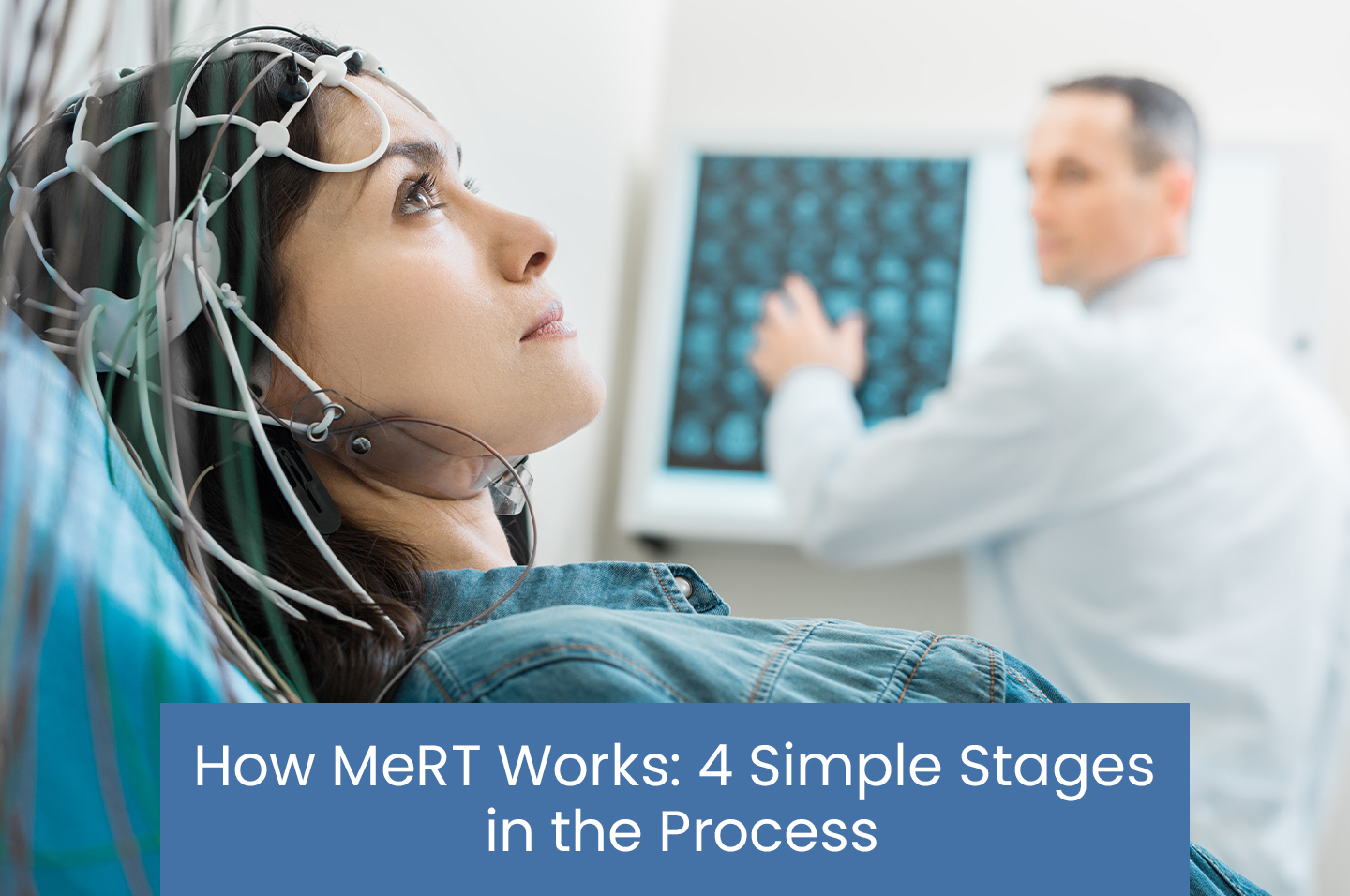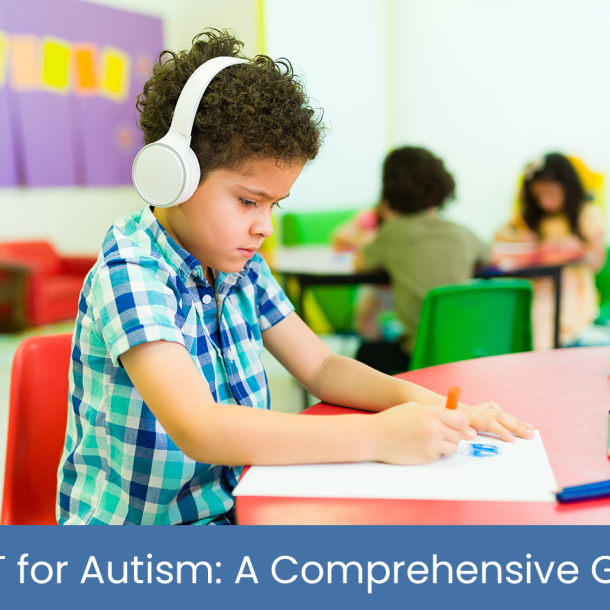
How MeRT Works: 4 Simple Stages in the Process
- Home /
- How MeRT Works: 4 Simple Stages in the Process

Your brain contains 100 billion neurons that regularly interact with each other. Most times, the brain functions as it should. However, certain causes can inhibit proper functioning and generate behavioural deviations. MeRT brain therapy allows professionals to view brain activity, compare it against others in our database, and devise a personalized treatment plan.
MeRT allows experts to see affected areas by viewing how the brain functions. With gentle brain stimulation, they can restructure how the brain works. MeRT treatments have experienced remarkable success in treating several conditions, ranging from autism to post-traumatic stress disorder (PTSD).
What is MeRT?
Magnetic Resonance Therapy (MeRT) provides a tailored use of TMS (Transcranial Magnetic Stimulation) based on a physician’s set of diagnostics. The procedure is a painless, non-invasive, and drug-free method to treat various neurological disorders.
Quantitative qEEG or EEG testing allows healthcare providers to view dysfunctional patterns in the brain and assists in diagnosis. MeRT testing identifies emotional disorders, learning and behavioural challenges, brain injuries, and more. A qEEG is useful in generating a map that outlines the patient’s best treatment options.
All treatment equipment is FDA-cleared. It works by using magnetic waves to stimulate specific areas of the brain. Clients undergoing MeRT treatments report incredible success in improving the following:
- Autism spectrum disorder
- Traumatic brain injuries (TBI)
- Post-traumatic stress disorder
- Concussions
- Depression
- Sleep disorders
- Anxiety
- Brain optimization
- Parkinson’s disease
- Stroke recovery
- Long COVID
How does the brain function?
To understand how MeRT works, we must first comprehend how the brain functions. By understanding functionality, you can see MeRT’s effectiveness regarding patient treatment.
Areas of your brain communicate in several ways, involving electrical or chemical signals. Electrical signals communicate by sending signals from your cell body to axon terminals via axons (thin fibres in the brain).
Communication moves across a synapse (an area between two neurons) in a chemical signal. They communicate when an action potential from one neuron releases chemical neurotransmitters to another. The neurotransmitter can assist or inhibit the next neuron from firing an action potential to determine the result.
How can neurons be disrupted?
Many events can disrupt the behaviours across neurons, including the following:
- Increased, prolonged stress or emotional trauma
- Sleep disorders
- Addictions or chemical traumas
- Congenital conditions
- Acute head injuries
Neuron disruption ranges from minor to major, with every person having different tolerance levels. However, with gentle treatments, brain improvements can occur.
How MeRt Works: A 4-Stage Process
As mentioned, MeRT uses EEG and qEEG to analyze and measure brainwave activity. They note brain network disruptions to establish treatment parameters customized to individual requirements.
MeRT works by reshaping brainwave activity independent of the original cause. There are four stages to how MeRT works.
1. Evaluation: A 10-minute recording of your brainwaves
Professionals do a 10-minute qEEG (quantitative electroencephalogram) and ask clients to close their eyes. An EKG (electrocardiogram) follows to detect heart rate, brainwave frequency, and heart-brain communication. Experts may also use repetitive transcranial magnetic stimulation (rTMS).
We measure each recording by the following:
- qEEG: This is a non-invasive method that places electrodes along your scalp. It measures brainwave activity.
- ECG/EKG: This measures electrical signals from the heart. It assists in customizing therapy to ensure treatments are accurate.
- rTMS: Magnetic coils go along the scalp and stimulate targeted brain areas.
2. Protocol and analysis
Your results are sent to a cloud platform where we analyze them against other recordings. Then, we convert your digital brain image into a comprehensive report containing age/gender-matched comparisons and insights.
Experts identify brain areas that are not correctly functioning. They use the report to complete a specific treatment protocol and track individual progress over an established time.
3. Treatment plan/delivery
If experts determine that customized brain stimulation will benefit you, we establish a protocol based on your brainwave, recording data that we deliver using in-clinic therapy (MeRT).
Professionals schedule daily sessions for five days weekly, lasting 30 minutes over a one-month period. During one month, tailored protocols choreograph your brainwave activities into synchronized states.
4. Recording reassessments and evaluation of progress
After a few weeks, an additional 10-minute session with eyes closed detects brainwave activity changes. This allows us to assess how well treatments are working from brainwave stimulation.
Experts objectively measure and manage sequential recordings after ten days. We measure progress using several third-party neurocognitive assessments, instruments, and questionnaires. These methods help experts to determine how you are responding to treatment.
Generally, treatments take six to eight weeks, depending on clinical response and your EEG results.
How does the process work in treating various conditions?
EKGs and qEEGs tell professionals how various brain locations function. This allows them to locate disruptions to a person’s brain network. Once identified, experts can outline an effective treatment plan.
Gentle magnetic waves reprogram your brain’s electrical signals. This allows healthcare experts to restore brain function and change behaviour.
What is the success rate of MeRT?
The results from MeRT note an improvement in behaviour severity in autistic children. It reports positive behavioural changes, mood, eye contact, language, and social interaction improvements.
A reduction of symptoms with PTSD, TBI, and depression clients has additionally been noted. Many clients also report increased sleep, mental clarity, and energy levels.
Is MeRT for everyone?
Each patient’s brain responds differently to treatment. The assessment period allows experts to determine whether the individual is a plausible candidate for MeRT treatment.
However, some conditions exclude a person from receiving MeRT treatment. These include those with the following:
- Defibrillator
- Pacemaker
- Magnetic intracranial shunt/VP shunt
- Vagal nerve stimulator
- Sheel shunts/stents
- Deep brain stimulator
- Cranial metal pieces (shrapnel)
- Aneurysm coils, clips, flow diversion, or pipelines
- Cochlear implant
- Breastfeeding or pregnant women
- Magnetic dental implants
- Primary brain cancer
- Ocular implants
Those with the conditions listed below may need closer attention. There is a 50/50 chance it may disqualify someone for treatment:
- Seizure
- Spinal cord stimulator
- Titanium stents and shunts
- Hearing aids
- Magnetic ink tattoo
- BAHA (bone-anchored hearing aid) implant
- Bipolar disorders types 1 and 2
Contact Neurosync Brain Treatment Centre
If you are considering MeRT brain therapy for yourself or a loved one, you can book an appointment online with Neurosync Brain Treatment Centre.
Clients can also email us at neurosyncbtc@outlook.com or phone us at 365-799-8438 for questions regarding MeRT therapy.
Working Hours
Email: neurosyncbtc@outlook.com
Woodbridge. ON. L4L 1A6

